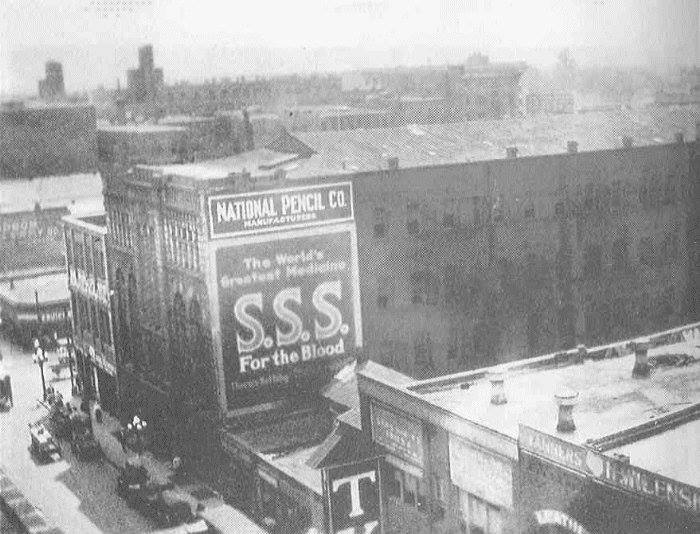
14 Mar THE TRIAL OF LEO FRANK, Part 2
THE MURDER THAT SHOCKED GEORGIA AND THE TRIAL OF LEO FRANK
PART-TWO
As the July 28 date for the opening of the Frank trial approached, Atlanta detectives, Solicitor Dorsey, and Conley’s own lawyer, William Smith, engaged Jim Conley in what later be called “midnight séances”: late-night sessions designed to turn Conley into the most effective possible prosecution witness. The men smoothed and refined the content of the sweeper’s testimony, as well as educated him on the importance of maintaining eye contact with the jury and other fine points of polished delivery. Smith played the role of Frank’s lead lawyer, Luther Rosser, subjecting Conley to test-runs of what was expected to be one of the roughest cross-examinations in Georgia’s criminal trial history. Smith later candidly stated his primary goal was “to render Conley impervious to cross-examination.”
Judge Leonard Roan called the case of the State versus Leo M. Frank under the tin ceiling of a courtroom in Atlanta’s City Hall. After each side used its twenty peremptory challenges (the prosecution struck all veniremen expressing opposition to capital punishment, while the defense used two of its challenges to remove the two African-American veniremen), a jury of twelve men, mostly under forty and married, was seated. An Atlanta newspaper declared the jury “much above average.”
Fannie Coleman, the mother of Mary, testified as the prosecution’s first witness. She told jurors that her daughter rose about 11:00 on Saturday, had a breakfast of cabbage and bread, and left home for the pencil factory “about a quarter to 12:00.” The witness hid tears behind a large palm-leaf fan as she identified the blood-stained clothes worn by Mary on the day she last saw her. Fifteen-year-old George Epps followed Coleman to the stand. Epps testified that on the day of the murder he rode the streetcar with Mary to a stop near the pencil factory, where she disembarked at 12:07.
Newt Lee provided the most important testimony of the trial’s opening day. Lee testified that at 7:00 p.m. on the evening of the murder he received a call from Frank (something that had never happened before) asking if things were okay at the plant. After telling jurors about his discovery of the body, Lee recalled what Frank told him during a break in a joint late-night interview with police two days after the murder. Complaining to Lee about his denials of any involvement with murder, Frank said: “If you keep this up, we’ll both go to hell.”
Prosecutor Dorsey and defense attorney Rosser fought each other to a rough draw over the several detectives who took the stand. Dorsey elicited testimony that supported his theory of the crime. He got officers to describe where Frank might have obtained a cord such as the one found around Mary’s neck and how Frank might have bolted the second-floor area in which the murder might have taken place. He secured testimony concerning red spots, presumably blood, found on the second-floor near the alleged murder site. He found a witness to report that Frank’s wife had said her husband had downed whiskey on the night following the crime. For his part, Rosser managed to raise doubts that the red spots were in fact blood, got detectives to concede that the basement door was crowbarred (suggesting the crime took place in the basement, not the second floor), and produced testimony that a cord similar to that found on Mary could be found at many places in the building.
Rosser, however, blew a great chance to explode the prosecution’s theory of the murder. Rosser argued that Frank and Conley took Mary’s body down the elevator shaft to the basement, and then dumped it in a corner. The opportunity to challenge the theory came when detective Boots Rogers testified what happened when they traveled down the elevator to begin their investigation: “When we went down on the elevator, the elevator mashed [human excrement]. You could smell it all around. It looked like the ordinary healthy man’s excrement.” In his statement to police, Jim Conley admitted depositing the excrement in the shaft—before the time of the murder. Thus, if Rosser had been on his game, he might have observed that the elevator, which always touches the bottom of the shaft, could not have been used to carry Mary’s body if Conley’s time line was accurate. But the moment passed.
Dr. Henry Harris, the doctor who conducted the autopsy of Pagan, identified strangulation as the cause of death “beyond a doubt.” He also concluded from nearly intact cabbage found inside the girl’s stomach that Mary was killed only 30 to 45 minutes after finishing her late breakfast at home. Harris also testified that “an injury had been made in the vagina some little time before death.” He also claimed to have found “evidence of violence in the neighborhood of the hymen.” (However, another prosecution doctor on cross-examination said he “saw no indication of injury to the hymen.”)
The most eagerly anticipated prosecution witness, the witness upon which the whole case ultimately hinged, was Jim Conley. On the morning of his testimony, a quarter-mile long line of would-be spectators stretched from the courthouse to the state capitol. Conley, usually a man of shabby clothes and filthy appearance, wore new clothes and sported a neatly combed fresh haircut, as he walked to the witness stand. Dorsey began his examination: “Do you know Leo Frank?”
A rapt courtroom listened as Conley told his tale of the last hours of Mary Phagan’s life. Conley testified that Frank told him that a girl would be coming by for “a chat” and that he should listen for the superintendent’s foot stomp, which would be his signal to lock the front door. When he heard Frank whistle, he was to unlock the door. Conley told jurors that sometime after Mary arrived and went upstairs, he heard a scream coming from the direction of the metal room. Conley claimed to have then fallen asleep, to be woken by Frank’s stomping foot. Later, after hearing a whistle, Conley said he went up to Frank’s office where he found “Mr. Frank standing up there at the top of the step and shivering and trembling and rubbing his hands.” Conley said his boss “had a little rope in his hands” and “right funny” large eyes. According to Conley, Frank said:
“I wanted to be with the little girl, and she refused me, and I struck her and I guess I struck her too hard and she fell and hit her head against something, and I don’t know how she got hurt. Of course you know I ain’t built like other men.”
Mary Phagan was dead. Conley claimed Frank said “there would be money in it for me” if he helped dispose of the body. He claimed to have rolled the girl up in cloth and, with Frank’s help, took the body to the basement by way of the elevator. The murder notes were Frank’s idea, Conley testified. “Frank dictated the notes to me,” Conley claimed. He testified that Frank looked to the ceiling and said, “Why should I hang? I have wealthy friends in Brooklyn.” Conley said that he promised to return to the plant later and burn Phagan’s body in the basement furnace, but that he ended up a saloon, got drunk and fell asleep, and so the final disposal of the body never happened.
Conley testified that Mary Phagan was not the first female he had known Frank to approach sexually:
“I had seen…a lady in his office, and she was sitting down in a chair and she had her clothes up to here, and he was down on his knees, and she had her hands on Mr. Frank. I have seen him another time there in the packing room with a young lady lying on the table…”
Over three days and for sixteen hours, the defense hammered away at Conley. They succeeded in getting Conley to admit they he had lied several times to investigators and demonstrated that his memory, except for events specifically asked about by the prosecutor, was exceptionally poor. Still, however, for all of Luther Rosser’s assumed prowess as a master cross-examiner, Conley remained unshaken when it came to the key parts of his testimony.
The defense had several goals. First, they hoped to cast serious doubt on the prosecution’s time line and show that Frank had no opportunity to commit the murder at the time Conley said he did. Second, the defense planned to produce a series of character witnesses who, it hoped, would convince the jury that Leo Frank was not the type of man to assault a thirteen-year-old worker at his plant. Third, it hoped that by putting Frank himself on the stand they could present a more plausible account for Phagan’s murder, laying the deed squarely on Frank’s principal accuser, Jim Conley.
Collectively, the defense’s time line witnesses managed to account for all but about eighteen minutes (from 12:02 to 12:20) of the period of time in which the Phagan murder had to have taken place. Witnesses directly contradicted Conley’s account by placing Frank at his home around 1:30 on the day of the murder.
Over one hundred defense witnesses either attested to Frank’s good behavior or Conley’s bad behavior. Nearly twenty witnesses testified that Conley had a reputation for lying. The prosecution’s attempted to undercut the defense effort by posing questions so outrageous that even if met with a firm denial by the witness (as they almost always were) they might damage Frank’s reputation. For example, Dorsey asked one witness if he’d ever heard of Frank taking a young girl to a park, setting her on his lap, and “playing with her”? (This question prompted an outraged Lucille Frank to rise and defend her husband, shouting at the prosecutor: “No, nor you either–you dog!”) Another witness was asked whether he had heard stories of Frank “playing with nipples.” Dorsey also hinted through his questions on cross-examination that Frank was a homosexual, such as when the prosecutor inquired of a young office boy whether Frank had made improper sexual advances toward him.
On August 18, 1913, a pale Leo Frank, with hands clasped, began four hours of testimony that included a personal history and explanation of his supervisory duties at the pencil factory. On the day of the murder, Frank said, he checked a large number of invoices to ensure their accuracy. He was so occupied when Mary Phagan visited his office to collect her pay envelope. Frank told jurors that at the time, he didn’t even know her name: “I only recognized this little girl from having seen her around the plant.” Phagan took her paycheck and left his office. Frank told jurors that he never saw Mary alive again. He admitted to being “completely unstrung” by the discovery of the body. He said the sight of “that little girl on the dawn of womanhood so cruelly murdered” was “a scene that would have melted stone.” Frank called Conley’s testimony “a tissue of lies from first to last” and said the story of women coming to him “for immoral purposes is a base lie.” He finished his testimony with the words, “I have told you the truth, the whole truth.”
Rebuttal witnesses for the prosecution testified that Frank had a reputation for lasciviousness. Time and time again, Dorsey asked a parade of female former employees at the pencil factory to assess Frank’s reputation concerning “his attitude toward women,” and witness after witness replied, “bad.” Most damaging, sixteen-year-old Dewey Hall told jurors that she saw Frank talking to Mary Phagan “sometimes two or three times a day” and that she also saw him “put his hand on her shoulder.” Another witness reported seeing Frank and a female worker slip into a dressing room and “stay in there fifteen to thirty minutes.” None of what the many female rebuttal witnesses had to say concerned the day of Mary Phagan’s murder, but they left little doubt in jurors’ minds that Frank was hardly a picture of moral rectitude.
In his closing argument for the prosecution, Frank Hooper called Frank a “Dr. Jekyll” who, “when the shades of night come, throws aside his mask of respectability and is transformed into a Mr. Hyde.” He told jurors to secure justice for young Mary Phagan who “went blithely to get her $1.20…not knowing the horrible death that awaited her.” Hooper employed the region’s racial stereotyping to his advantage, arguing “You know these negroes” and suggesting the thought that Jim “would have written those notes by himself is absurd.”
Defense attorney Reuben Arnold argued that Frank was a victim of rampant Antisemitism. Frank’s great misfortune in this case, Arnold said, is that he “comes from a race of people that have made money.” Arnold told jurors that “if Frank hadn’t been a Jew he never would have been prosecuted.”
Turning to the prosecution’s evidence, Arnold dismissed the testimony of Frank’s lasciviousness as the bitter words “of disgruntled former employees.” Arnold continued: “Deliver me from these prudish fellows that never look at a girl and never puts his hand on her and is always talking about his own virtue.” He reminded jurors that “we are not trying this man for everything that might have been said about him; we are trying him for murder.” The real criminal, Arnold insisted, was Jim Conley who “lay in his cell and conjured up” the “monstrous story” he has told. The story was preposterous, he said, and contradicted on numerous points by the evidence. Arnold suggested that the murder was committed by “a drunken, crazed negro, hard up for money.” He theorized that when Conley grabbed for Mary’s bag, she might have fallen and then been pushed into the nearby elevator shaft. The several witnesses who placed Frank’s whereabouts around the time of the murder made in “as clear as a holy writ that Conley was lying.”
Luther Rosser followed his defense colleague with an even more venomous, and undeniably racist, attack on the prosecution’s chief witness. The prosecution tutored Conley and tried to “make him look like a respectable negro,” but the jurors shouldn’t allow themselves to be fooled by “a trained parrot.” He concluded by telling jurors that if they believed Jim Conley “it will be a shame on this great city.”
Hugh Dorsey, for the state of Georgia, had the last word. He accused the defense attorneys of appealing to racial prejudice to salvage a losing case. He denied that Frank was prosecuted because he was a Jew, observing: “This great people rise to heights sublime, but they sink to the depths of degradation, too, and they are amenable to the same laws as you or I and the black race.” Later in his argument, Dorsey faced Frank and stated the prosecution’s theory of the murder: “You assaulted her, and she resisted. She wouldn’t yield. You struck her and you ravished her and she was unconscious.” You killed Mary Phagan, Dorsey told Frank, “to save your reputation, because dead people tell no tales.” Concluding, Dorsey said “there can be but one verdict” and that, he told the jury twelve times between the rings of the bells of a nearby church as it signaled noon, is “guilty!”
The jury, balloting twice, deliberated less than two hours. Asked by Judge Roan whether the jury had reached a verdict, jury foreman Fred Wilburn replied: “We have, your honor. We have found the defendant guilty.”
People leaving the courtroom were greeted by an astonishing spectacle. For blocks around, cheering people filled the streets of Atlanta.
The next day, Judge Roan pronounced sentence. He ordered that on October 10, 1913, Leo Frank “be hanged by the neck until he shall be dead, and may God have mercy on his soul.”
In Part Three, the new evidence, the doubt of conviction and the tragic end.



No Comments